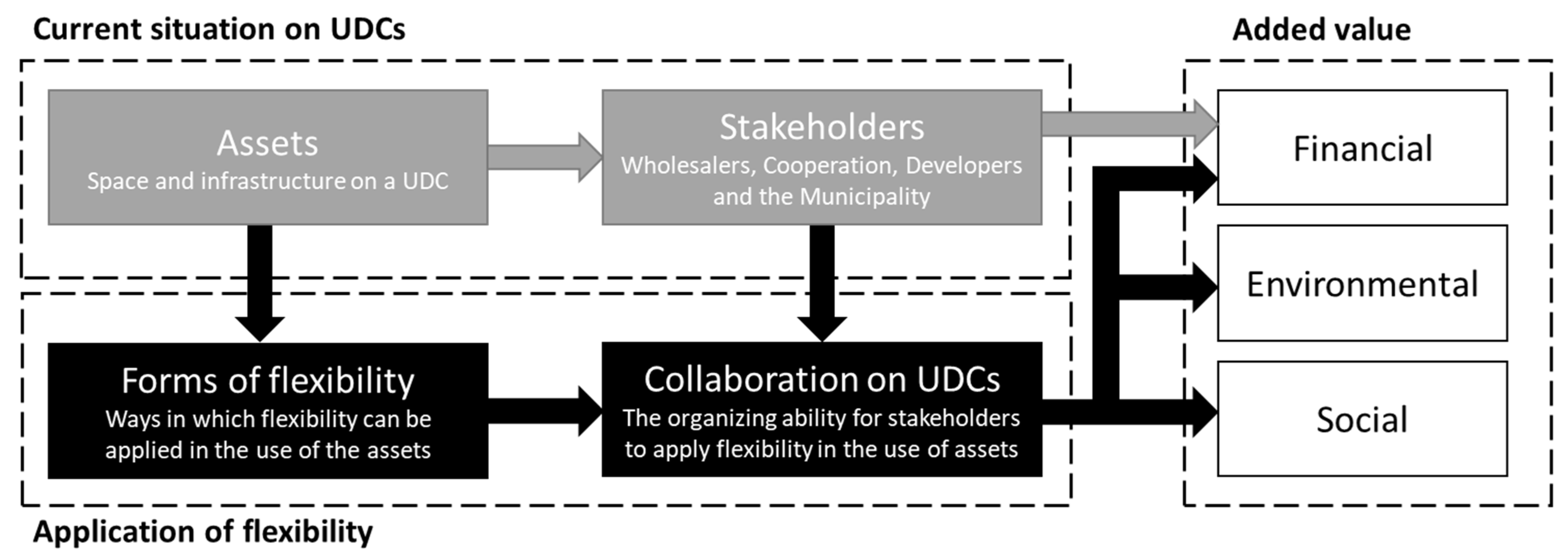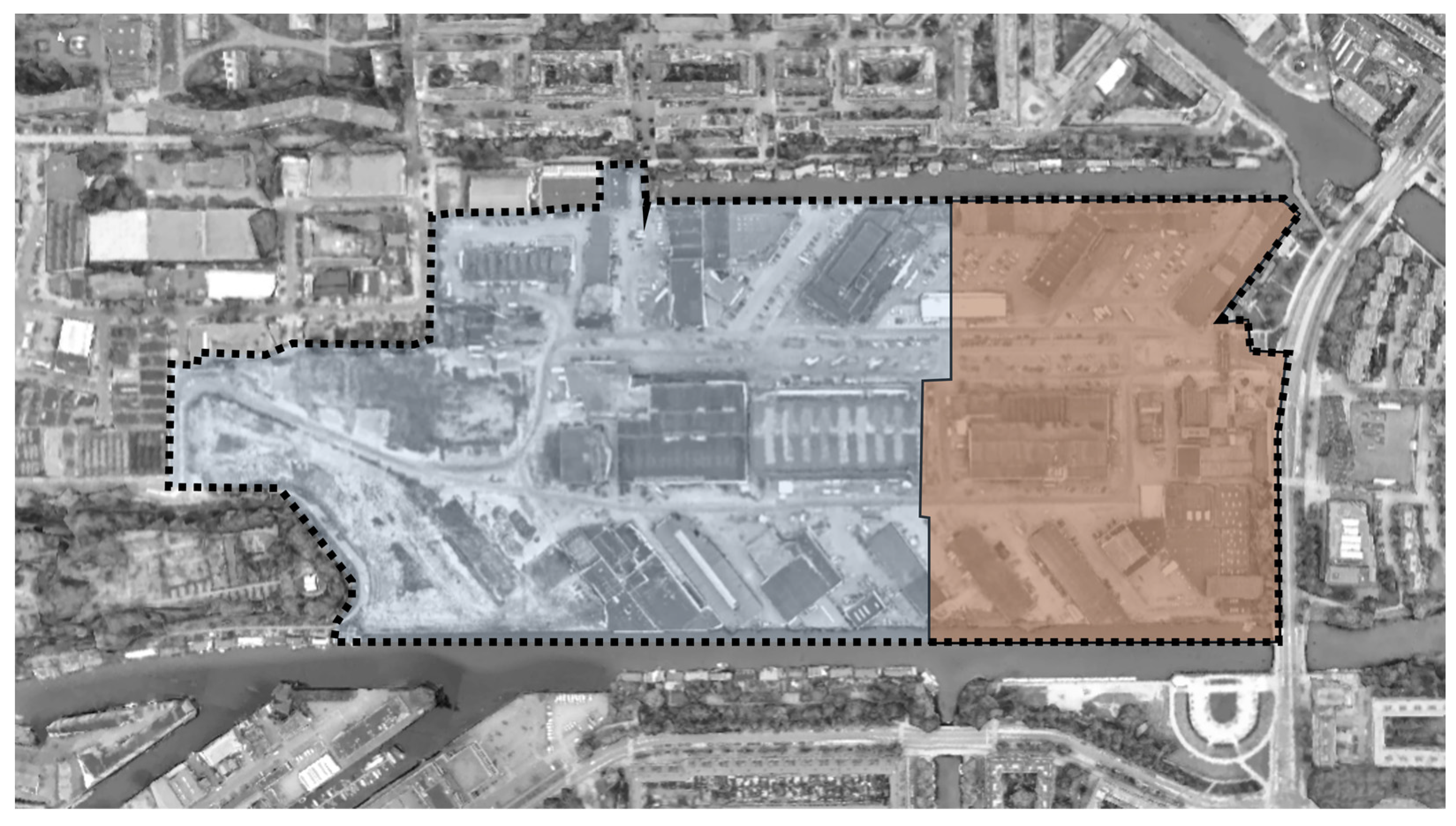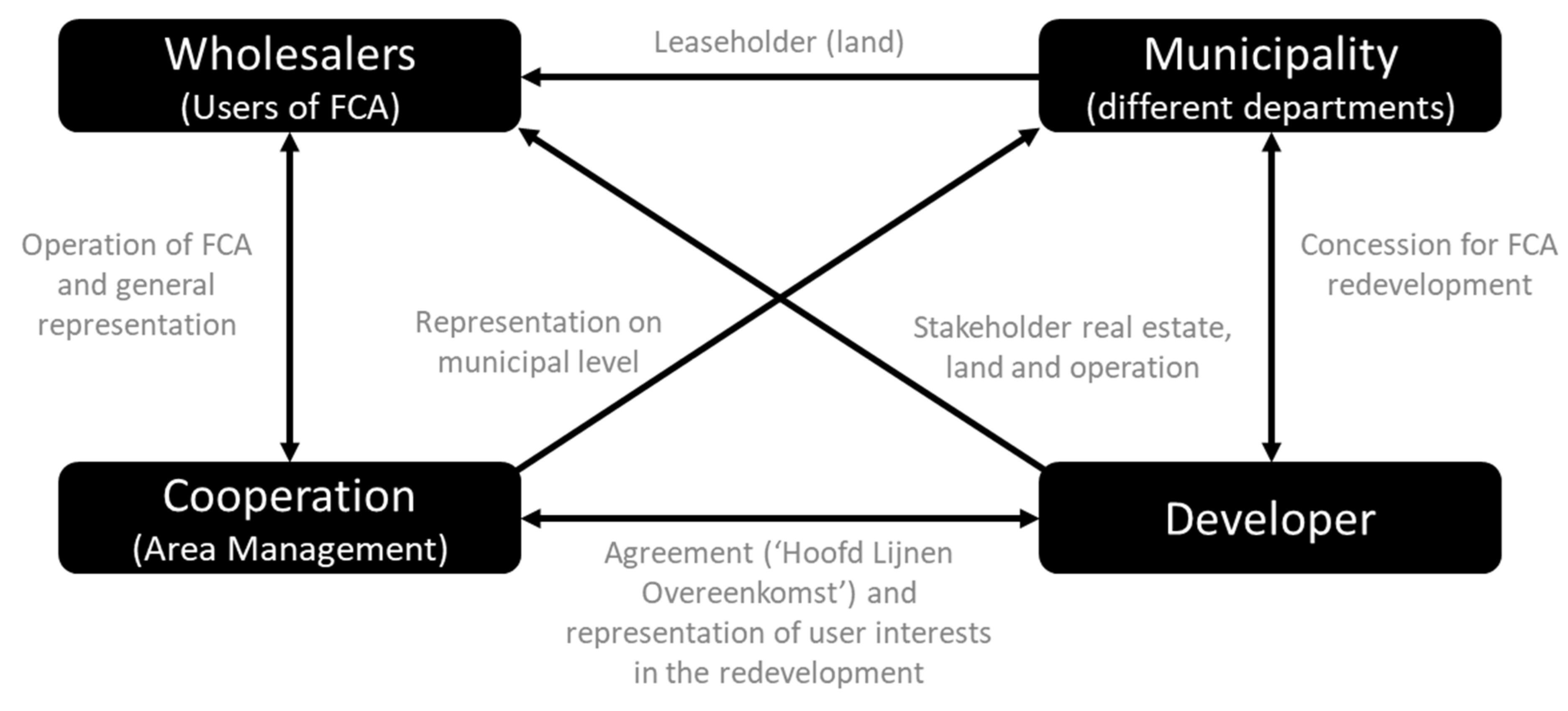Can We Do More with Less? Analyzing the Organization of Flexibility of Space and Infrastructure at UDCs: A Case Study for Food Center Amsterdam
Abstract
1. Introduction
2. Literature Review
2.1. Aproach to the Literature Review
2.2. Literature Review of Flexibility and Collaboration between Stakeholders for UDCs
2.2.1. Forms of Flexibility of Space and Infrastructure
2.2.2. Collaboration on UDCs
2.3. A Framework for the Application of Flexibility and Its Added Value for UDCs
3. Method
- What is the understanding of flexibility and its forms?
- What is the perception of the potential added value of forms of flexibility, both in general and case-specific?
- What interests do stakeholders have in relation to flexibility applications?
- In what way can collaboration be organized to achieve the potential value of flexibility?
4. The Study Object: Food Center Amsterdam
4.1. The Context of Food Center Amsterdam
4.2. The Physical Object Aspects of FCA
4.3. The Stakeholders and Their Relations at FCA
5. Results and Analysis
5.1. Results and Analysis of Organizing Collaboration on Flexibility
5.1.1. There Is a Limited Understanding of What Flexibility Is and When to Apply It
5.1.2. The Potential for a Value Case for Flexibility Is Seen, the Business Case Is More Difficult
5.1.3. A Challenge Lies in the Alignment of Stakeholders’ Interests to Come to a Win-Win
5.1.4. The Organization of Collaboration on Flexibility Requires Initiation, Independent Au-Thority, and a Fair Division of Costs and Benefits
5.2. Reflection on the Case and Its Added Value
6. Conclusions
Author Contributions
Funding
Data Availability Statement
Conflicts of Interest
Appendix A
| Interviewee Type | Organization | Role |
|---|---|---|
| Users (Companies present at FCA) | Bidfood | Branch Director |
| Jan van As Vishandel | Director | |
| Area management | Vereniging Herstructurering FCA | Chairman |
| Vereniging Herstructurering FCA | Former coordinator negotiation and planning | |
| Coöperatie FCA | Project lead | |
| Municipality | Gemeente Amsterdam, Verkeer & Openbare Ruimte | Strategist |
| Gemeente Amsterdam, Economische Zaken | Spatial economic advisor | |
| Gemeente Amsterdam, Programma Logistiek | Senior advisor logistic hubs | |
| Developers/advisors | Intospace | Project manager CLIC |
| STEC Groep | Director | |
| n/a | Development Manager | |
| Transport Authority/Metropolitan Region Amsterdam | Vervoerregio Amsterdam/Metropoolregio Amsterdam | Network director |
| Knowledge Institutes | Hogeschool van Amsterdam | Professor in City Logistics |
| Hogeschool van Amsterdam | Lector/Researcher Food Logistics | |
| BUAS/TNO | Lector/Senior Scientist | |
| Experts | ALICE | Director |
| Leen Menken Foodservice Logistics | Founder/Advisor |
References
- PBL. Prognose: In 2035 Vooral Meer Inwoners in en om Grotere Gemeenten. Available online: https://www.pbl.nl/nieuws/2022/prognose-in-2035-vooral-meer-inwoners-in-en-om-grotere-gemeenten (accessed on 6 July 2022).
- TNO. Elektrisch Rijden Personenauto’s en Logistiek: Trends en Impact op Het Elektriciteitsnet. Planbureau voor de Leefomgeving. 2022. Available online: https://www.pbl.nl/sites/default/files/downloads/pbl-2022-elektrisch-rijden-personenautos-en-logistiek-trends-en-impact-op-het-elektriciteitssysteem-4973.pdf (accessed on 1 December 2022).
- ICCT. Update on Zero-Emission Zone Development Progress in Cities. Available online: https://theicct.org/publication/update-on-zero-emission-zone-progress-aug22/ (accessed on 30 August 2022).
- Green Deal. Zero Emission Stadslogistiek—Samenvatting Green Deal 173. Available online: https://www.greendeals.nl/green-deals/zero-emission-stadslogistiek (accessed on 16 July 2018).
- Bachofner, M.; Lemardelé, C.; Estrada, M.; Pagès, L. City logistics: Challenges and opportunities for technology providers. J. Urban Mobil. 2022, 2, 100020. [Google Scholar] [CrossRef]
- TOI. European Cities with Car-Free City Centres. 2016. Available online: https://www.toi.no/getfile.php/1342377-1458656602/Publikasjoner/T%C3%98I%20rapporter/2016/1476-2016/1476-2016-sum.pdf (accessed on 1 December 2022).
- Oxford Dictionary. Definition of Flexibility in English. Available online: https://en.oxforddictionaries.com/definition/us/flexibility (accessed on 2 January 2017).
- Pennings, R.; Wiegmans, B.; Spit, T. Are We Missing the Bus? A Case Study on Flexibility Options for Charging Infrastructure at the Amsterdam Central Station. Infrastructures 2023, 8, 47. [Google Scholar] [CrossRef]
- Sanchez-Silva, M. Managing Infrastructure Systems through Changeability. J. Infrastruct. Syst. 2019, 25, 04018040. [Google Scholar] [CrossRef]
- UN Habitat. Envisaging the Future of Cities; United Nations Human Settlements Programme (UN-Habitat): Nairobi, Kenya, 2022. [Google Scholar]
- Lagorio, A.; Pinto, R.; Golini, R. Research in urban logistics: A systematic literature review. Int. J. Phys. Distrib. Logist. Manag. 2016, 46, 908–931. [Google Scholar] [CrossRef]
- Campbell, J.F.; O’Kelly, M.E. Twenty-Five Years of Hub Location Research. Transp. Sci. 2012, 46, 153–169. [Google Scholar] [CrossRef]
- Quak, H.; Van Duin, R.; Hendriks, B. Runnings an urban consolidation centre: Binnenstadservice 10 years back and forth. Transp. Res. Procedia 2020, 46, 45–52. [Google Scholar] [CrossRef]
- Pennings, R.; Wiegmans, B.; Spit, T. Can We Have Our Cake and Still Eat It? A Review of Flexibility in the Structural Spatial Development and Passenger Transport Relation in Developing Countries. Sustainability 2020, 12, 6091. [Google Scholar] [CrossRef]
- Kin, B.; Verlinde, S.; Mommens, K.; Macharis, C. A stakeholder-based methodology to enhance the success of urban freight transport measures in a multi-level governance context. Res. Transp. Econ. 2017, 65, 10–23. [Google Scholar] [CrossRef]
- Van Duin, R.; Slabbekoorn, M.; Tavasszy, L.; Quak, H. Identifying dominant stakeholder perspectives on urban freight policies: A Q-analysis on urban consolidation centres in the Netherlands. Transport 2018, 33, 867–880. [Google Scholar] [CrossRef]
- Xiao, Z.; Yuan, Q.; Sun, Y.; Sun, X. New paradigm of logistics space reorganization: E-commerce, land use, and supply chain management. Transp. Res. Interdiscip. Perspect. 2021, 9, 100300. [Google Scholar] [CrossRef]
- Kennisinstituut voor Mobiliteitsbeleid. Verkenning van het Concept Mobiliteitshub. Available online: https://www.kimnet.nl/publicaties/rapporten/2021/05/31/verkenning-van-het-concept-mobiliteitshub (accessed on 31 May 2021).
- Rodrigue, J.-P. Logistics and Freight Distribution. 2020. Available online: https://transportgeography.org/contents/chapter7/logistics-freight-distribution/ (accessed on 1 December 2022).
- Snoeck, A.; Winkenbach, M. The value of physical distribution flexibility in serving dense and uncertain urban markets. Transp. Res. Part A 2020, 136, 151–177. [Google Scholar] [CrossRef]
- Custodio, L.; Machado, R. Flexible automated warehouse: A literature review and an innovative framework. Int. J. Adv. Manuf. Technol. Vol. 2019, 106, 533–558. [Google Scholar] [CrossRef]
- Torres-Rincon, S.; Villarraga, D.F.; Sánchez-Silva, M. Conceptual and Numerical Analysis of Flexibility in Infrastructure Systems. J. Infrastruct. Syst. 2020, 26, 04020012. [Google Scholar] [CrossRef]
- Sanchez-Silva, M.; Calderon-Guevara, W. Flexibility and adaptability within the context of decision-making in infrastructure management. Struct. Infrastruct. Eng. 2022, 18, 950–966. [Google Scholar] [CrossRef]
- Egyedi, T.; Spirco, J. Standards in transitions: Catalyzing infrastructure change. Futures 2011, 43, 947–960. [Google Scholar] [CrossRef]
- Van Duin, R.; van den Band, N.; de Vries, A.; Verschoor, P.; el Ouasghiri, M.; Warffemius, P.; Anand, N.; Quak, H. Sharing logistics in urban freight transport: A study in 5 sectors. In Proceedings of the 5th International Conference Green Cities 2022: Green Logistics for Greener Cities, Vienna, Austria, 20–21 October 2022; pp. 1–11. [Google Scholar]
- Yea, M.; Chung, S.; Cheong, T.; Kim, D. The Sharing of Benefits from a Logistics Alliance Based on a Hub-Spoke Network: A Cooperative Game Theoretic Approach. Sustainability 2018, 10, 1855. [Google Scholar] [CrossRef]
- Morganti, E.; Gonzalez-Feliu, J. City logistics for perishable products. The case of the Parma’s Food Hub. Case Stud. Transp. Policy 2015, 3, 120–128. [Google Scholar] [CrossRef]
- Rai, H.B.; Kang, S.; Sakai, T.; Tejada, C.; Yuan, Q.J.; Conway, A.; Dablanc, L. ‘Proximity logistics’: Characterizing the development of logistics facilities in dense, mixed-use urban areas around the world. Transp. Res. Part A 2022, 166, 41–61. [Google Scholar]
- Quak, H.; Balm, S.; Posthumus, B. Evaluation of City Logistics Solutions with Business Model Analysis. Procedia-Soc. Behav. Sci. 2014, 125, 111–124. [Google Scholar] [CrossRef]
- Zenezini, G.; van Duin, R.; Tavasszy, L.; De Marco, A. Stakeholders’ roles for business modelling in a city logistics ecosystem: Towards a conceptual model. In City Logistics 2: Modeling and Planning Initiatives; Wiley Online Library: Hoboken, NJ, USA, 2017; pp. 344–358. [Google Scholar]
- Van Duin, R.; Quak, H.; Anand, N.; Van den Band, N. Designing sharing logistics as a disruptive innovation in city logistics. In Proceedings of the 4th International Conference Green Cities, Online Event, 3–5 June 2020. [Google Scholar]
- Balm, S.; Browne, M.; Leonardi, J.; Quak, H. Developing an Evaluation Framework for Innovative Urban and Interurban Freight Transport Solutions. Procedia-Soc. Behav. Sci. 2014, 125, 386–397. [Google Scholar] [CrossRef][Green Version]
- Russo, S.M.; Voegl, J.; Hirsch, P. A multi-method approach to design urban logistics hubs for cooperative use. Sustain. Cities Soc. 2021, 69, 102847. [Google Scholar] [CrossRef]
- Vuorinen, L.; Martinsuo, M. Value-oriented stakeholder influence on infrastructure projects. Int. J. Proj. Manag. 2019, 37, 750–766. [Google Scholar] [CrossRef]
- Anderluh, A.; Hemmelmayr, V.C.; Rüdiger, D. Analytic hierarchy process for city hub location selection—The Viennese case. Transp. Res. Procedia 2020, 46, 77–84. [Google Scholar] [CrossRef]
- Buldeo Rai, H.; Van Lier, T.; Meers, D.; Macharis, C. Improving urban freight transport sustainability: Policy assessment framework and case study. Res. Transp. Econ. 2017, 64, 26–35. [Google Scholar] [CrossRef]
- Macharis, C.; Kin, B. The 4 A’s of sustainable city distribution: Innovative solutions and challenges ahead. Int. J. Sustain. Transp. 2017, 11, 59–71. [Google Scholar] [CrossRef]
- Van Duin, R.; Quak, H.; Munzuri, J. New challenges for urban consolidation centres: A case study in The Hague. Procedia Soc. Behav. Sci. 2010, 2, 6177–6188. [Google Scholar] [CrossRef]
- Morel, M.; Balm, S.; Berden, M.; Ploos van Amstel, W. Governance models for sustainable urban construction logistics: Barriers for collaboration. Transp. Res. Procedia 2020, 46, 173–180. [Google Scholar] [CrossRef]
- Freichel, S.; Annika, N.; Wortge, J. The role of urban logistics real estate in last mile deliveries: Opportunities, challenges and succes factors for integration. In Proceedings of the 19th International Conference Business Logistics in Modern Management, Osijek, Croatia, 10–11 October 2019; pp. 441–457. [Google Scholar]
- Pedrini, M.; Ferri, L.M. Stakeholder management: A systematic literature review. Corp. Gov. 2019, 19, 44–59. [Google Scholar] [CrossRef]
- Nguyen, T.S.; Mohamed, S.; Panuwatwanich, K. Stakeholder Management in Complex Project: Review of Contemporary Literature. J. Eng. Proj. Prod. Manag. 2018, 8, 75–89. [Google Scholar] [CrossRef]
- Freeman, R.E.; McVea, J. A Stakeholder Approach to Strategic Management. In The Blackwell Handbook of Strategic Management; Wiley Online Library: Hoboken, NJ, USA, 2005; pp. 183–201. [Google Scholar]
- Bridoux, F.; Stoelhorst, J. Stakeholder Governance: The collective action problems in joint value creation. Acad. Manag. Rev. 2022, 47, 214–236. [Google Scholar] [CrossRef]
- Flyvbjerg, B. Case Study. In The SAGE Handbook of Qualitative Research—4th Revised Edition; Denzin, N.K., Lincoln, Y.S., Eds.; Sage Publications Inc.: Thousand Oaks, CA, USA, 2011; pp. 301–316. [Google Scholar]
- Crowe, S.; Cresswell, K.; Robertson, A.; Huby, G.; Avery, A.; Sheikh, A. The case study approach. BMC Med. Res. Methodol. 2011, 11, 100. [Google Scholar] [CrossRef]
- Food Center Amsterdam. Home. 4 February 2023. Available online: https://www.foodcenter.nl/ (accessed on 1 December 2022).
- Gemeente Amsterdam. Food Center Amsterdam—1e Uitwerking. 19 October 2022. Available online: https://www.ruimtelijkeplannen.nl/web-roo/transform/NL.IMRO.0363.E2005BPGST-OW01/pt_NL.IMRO.0363.E2005BPGST-OW01.xml#NL.IMRO.PT.s195 (accessed on 1 December 2022).
- Liander. Transportcapaciteit Amsterdam. 22 June 2023. Available online: https://www.liander.nl/grootzakelijk/transportschaarste/beschikbaarheid-capaciteit/amsterdam (accessed on 1 December 2022).
- Marktkwartier. Plan in Beeld. 2020. Mecanoo. Available online: https://www.omgevingmarktkwartierwest.nl/userfiles/files/beeldkwaliteitsplan-marktkwartier.pdf (accessed on 1 December 2022).



| Stakeholder Type | Responsibilities |
|---|---|
| Wholesalers (Users of FCA with their own physical location; companies) | This includes major (e.g., BidFood) and smaller companies (e.g., companies in specific perishable goods). These companies are all member of the cooperation. The wholesalers are mainly business-case driven. |
| Cooperation (Area management: includes both Vereniging Herstructurering and Coöperatie FCA) | The cooperation represents the interests of all (member) companies in the FCA-area and is responsible for the management of the area. It coordinates collaboration on, e.g., collective garbage disposal, collective energy approaches, and charging infrastructure. Vereniging Herstructurering exists to support the wholesalers with the process of the restructuring of the area. |
| Developer (consortium Marktkwartier) | Developers are responsible for the redevelopment of the area. The consortium Marktkwartier holds the concession. The consortium is a joint venture of Ballast Nedam Development BV and VolkerWessels Vastgoed BV. |
| Municipality (Gemeente Amsterdam) | The municipality is responsible for public space, land, and transport infrastructure, and is the commissioning party for the Marktkwartier (concession). The municipality is owner of the land of FCA, and part is under leasehold (‘erfpacht’) [48]. Relevant departments of the municipality include Verkeer en Openbare Ruimte, Ruimte en Duurzaamheid, Economische Zaken, Grond en Ontwikkeling, and Deelnemingen. These departments can have different interests, therefore the municipality can be seen as a number of stakeholders. The focus of the municipality has both societal and financial perspectives. |
Disclaimer/Publisher’s Note: The statements, opinions and data contained in all publications are solely those of the individual author(s) and contributor(s) and not of MDPI and/or the editor(s). MDPI and/or the editor(s) disclaim responsibility for any injury to people or property resulting from any ideas, methods, instructions or products referred to in the content. |
© 2023 by the authors. Licensee MDPI, Basel, Switzerland. This article is an open access article distributed under the terms and conditions of the Creative Commons Attribution (CC BY) license (https://creativecommons.org/licenses/by/4.0/).
Share and Cite
Pennings, R.; Wiegmans, B.; Spit, T. Can We Do More with Less? Analyzing the Organization of Flexibility of Space and Infrastructure at UDCs: A Case Study for Food Center Amsterdam. Logistics 2023, 7, 90. https://doi.org/10.3390/logistics7040090
Pennings R, Wiegmans B, Spit T. Can We Do More with Less? Analyzing the Organization of Flexibility of Space and Infrastructure at UDCs: A Case Study for Food Center Amsterdam. Logistics. 2023; 7(4):90. https://doi.org/10.3390/logistics7040090
Chicago/Turabian StylePennings, Rogier, Bart Wiegmans, and Tejo Spit. 2023. "Can We Do More with Less? Analyzing the Organization of Flexibility of Space and Infrastructure at UDCs: A Case Study for Food Center Amsterdam" Logistics 7, no. 4: 90. https://doi.org/10.3390/logistics7040090
APA StylePennings, R., Wiegmans, B., & Spit, T. (2023). Can We Do More with Less? Analyzing the Organization of Flexibility of Space and Infrastructure at UDCs: A Case Study for Food Center Amsterdam. Logistics, 7(4), 90. https://doi.org/10.3390/logistics7040090






